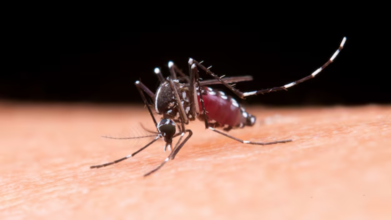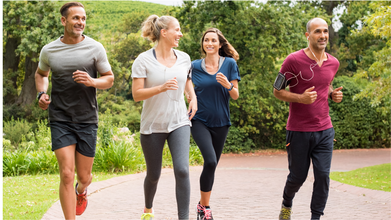- Health Conditions A-Z
- Health & Wellness
- Nutrition
- Fitness
- Health News
- Ayurveda
- Videos
- Medicine A-Z
- Parenting
Why Do Mosquitoes Bite Some People More Than The Others?

Mosquitoes Bite Some People (Credit-Freepik)
Mosquitoes are a big part of the ecosystem, but often are a nuisance as they bite and feed off of us. Their bites cause itchy red bumps and spread infections and allergies in our bodies. But have you ever wondered why they bite certain people more than others? While some people are plagued by mosquito bites, others barely notice them. Here are some interesting facts about mosquitoes that you must know about!
1. Carbon Dioxide:
Mosquitoes are attracted to a certain smell that emits from the human body that is present in the human skin and sweat, mosquitoes can sense the carbon dioxide or CO2 we breathe out. The more active you are, the more CO2 you emit and the more mosquitoes will be attracted to you. Researchers are still investigating the cause of the variation of body odour that brings them to you, possibly genetics or certain bacteria. The unique combination of sweat and skin bacteria creates a scent that mosquitoes find irresistible. Some chemicals in sweat, like lactic acid and ammonia, are especially attractive to them.
2. Colours
While the reason isn't fully understood, mosquitoes seem to be drawn to dark colours like black more than lighter ones. So, ditch the dark outfit next time you're in mosquito territory. It has been noted that mosquitoes are more likely to leave lighter colours alone.
3. Heat and Vapour
Mosquitoes can detect your body's heat and water vapour, acting like a beacon guiding them right to you. So next time you're feeling sweaty, be aware you might be attracting a lot of mosquitoes. If you are working out or doing something that is making you sweat and your body heat rise, the mosquitoes nearby will be instantly attracted to you. Even mosquitoes are careful about who they pick as a host, some studies even suggest that they like a certain body temperature to feed off of.
An interesting fact about mosquitoes is that they can learn to like a host. They have their own preferences and if they meet a certain person who fits their criteria they might be the next host they move onto. In an older study, it showed that 20 per cent of people with mosquito-borne diseases accounted for 80 per cent of diseases transmitted in the population. They suggest that they only bite a certain set of people within the population.
4. Other factors:
Studies suggest mosquitoes might learn to prefer certain people based on things like what you've been drinking. In a 2002 study, there could be many reasons they like alcohol to making your body temperature high etc. Even pregnant women seem to be extra attractive to them due to higher body temperature and CO2 output.
Working Out For 10 Minutes May Decrease Your Risk Of Colorectal Cancer, Study Proves

Credit: Canva
Performing short and intense exercises that last for about 10 minutes may significantly reduce the risk of colorectal cancer, a British study shows.
Researchers at Newcastle University have found that completing brief workouts increases the concentration of several small molecules in the blood that have previously been linked to reducing inflammation, improving blood vessel function and metabolism.
The findings, which were published in the International Journal of Cancer, also noted that even short bouts of exercise can influence the activity of genes that govern tumor growth and fight against cancer.
Dr Sam Orange, Senior Lecturer in Clinical Exercise Physiology at Newcastle University and lead study author, said of the results, "What’s remarkable is that exercise doesn’t just benefit healthy tissues, it sends powerful signals through the bloodstream that can directly influence thousands of genes in cancer cells.
“It’s an exciting insight because it opens the door to find ways that mimic or augment the biological effects of exercise, potentially improving cancer treatment and, crucially, patient outcomes.
“In the future, these insights could lead to new therapies that imitate the beneficial effects of exercise on how cells repair damaged DNA and use fuel for energy.”
How Does It Work?
The study involved 30 participants, both male and female between the ages of 50–78. All of the participants were overweight or obese (a risk factor of cancer) but otherwise healthy.Researchers had asked each volunteer to complete a short, intense cycling test that lasted about 10 minutes and collected each of their blood samples which were then meticulously analyzed.
After studying about 249 proteins, the experts found nearly 13 protein had increased in their blood flow after the short exercise including interleukin-6 (IL-6), which helps repair the DNA of damaged cells.
When these exercise-induced proteins were applied to colorectal or bowel cancer cells by the scientists in a lab, they discovered that these new proteins could alter the activity of over 1,300 genes, particularly those who were responsible for DNA repair, energy production and cancer cell growth.
As a result, they concluded that performing even small exercises can activate a set of genes in the body's cells that can support efficient use of oxygen and promote energy metabolism. Additionally, the British researchers also discovered that the cell genes which have been previously associated with rapid cell growth were switched off after working out, suggesting that this might aid in controlling cancerous growths in the body.
What Is Colorectal Cancer?
Colorectal or bowel cancer is a common cancer that forms in the tissues of the colon (large intestine) or rectum, often starting as non-cancerous growths called polyps that turn cancerous over time.
Despite being treatable and preventable, colorectal cancer is currently the second leading cause of cancer-related deaths worldwide. Over 70,000 new cases of colorectal cancer occur annually in India, making it the fourth most common cancer in the country.
Typical symptoms usually include :
- Blood in or on the stool
- Changes in bowel habits (diarrhea, constipation, narrower stools)
- Abdominal discomfort, cramps, gas, or pain
- Feeling that your bowel doesn't empty completely
- Weakness, fatigue, or unexplained weight loss
Expert Explains: Why Do Allergies And Rashes Increase In Winter? According To Dermatologist

Credits: iStock
When temperature drops, so does the moisture even in your skin. This is what leads to a rash or allergies. In fact, with changes in temperature, and winters, our lifestyle changes too, this could also be the reason why we experience a winter rash, or allergies. To understand this better, Health and Me spoke to Dr Navjot Arora, Consultant Dermatologist, Dermaheal Skin and Clinic at Dwarka, Delhi, who explained that allergies and skin rashes tend to increase during winter due to both, environmental factors and changes in skin health. "Cold temperatures and low humidity levels reduce moisture in the air, leading to excessive dryness of the skin. When the skin becomes dry, its natural protective barrier weakens. This makes it more prone to irritation, inflammation, and allergic reactions."
Why Does Winter Weather Increase Chances Of Rashes And Allergies?
The doctor explains that during winter, people tend to stay indoors more, and it also increases their exposure to allergens like dust mites, mold, pet dander, and chemical fumes from heaters and cleaning products. "Limited ventilation and closed spaces allow these allergens to build up, triggering allergic responses and skin rashes, especially in individuals with sensitive skin or pre-existing conditions like eczema."
Cold weather also affects blood circulation to the skin. Reduced blood flow can slow down the skin’s repair process and weaken its defense against irritants and allergens. As a result, chronic skin conditions such as eczema, psoriasis, and contact dermatitis often worsen in winter, leading to itching, redness, flaking, and rashes.
Lifestyle Changes In Winter
Doctor also points out that during winters, our bathing habit changes. Dr Arora says, "Frequent hot showers strip away the skin’s natural oils, increasing dryness and irritation. In addition, wearing heavy woolen or synthetic clothing can cause friction, sweating, and contact allergies, particularly in skin folds, which can further contribute to rashes."
Common Symptoms Of Winter Rashes
- flushing
- swelling
- itching
- flaking skin
- sensitivity
- bumps
- blisters
If not treated well, or in time, it can develop into more serious health threat, especially if you have a family history of
- eczema or another type of dermatitis
- psoriasis
- rosacea
- allergies
- asthma
- sensitive skin
What Are The Cures To Winter Rashes And Allergies?
The rise in allergies and rashes during winter is largely linked to dry weather, indoor allergen exposure, and skin barrier damage. Maintaining proper skin hydration, avoiding harsh soaps, limiting hot water exposure, and wearing skin-friendly fabrics can help reduce the risk of winter-related allergies and skin rashes.
Moisturizers are usually the first line of care for dry skin because they help trap moisture and prevent further dryness. Apply them multiple times a day, especially after bathing or washing your hands. Thicker options like creams or ointments tend to keep skin hydrated longer than lighter lotions.
Petroleum jelly can also be effective, as it forms a protective barrier that seals in moisture. If you prefer to avoid petroleum-based products, alternatives like Waxelene or Un-Petroleum work in a similar way to reduce moisture loss.
Natural virgin oils, such as coconut oil, may help calm irritated skin and restore hydration. Use them on areas that are not acne-prone, and always do a patch test on a small area for 24 hours before wider application.
Oatmeal-based soaps or oatmeal baths can also help soothe dry, itchy skin. You can buy ready-made oatmeal soaps or add finely ground oats to a warm bath and soak for about 10 minutes.
For itching and inflammation, topical hydrocortisone creams, available over the counter or by prescription, may provide relief. Always follow the instructions on the label or use them as advised by a doctor.
Disclaimer: This is not a substitute for actual prescribed medicine. Please consult a doctor before you purchase any medicine or ointment for your rashes.
Are You Taking Clonazepam? NHS Issues Urgent Safety Advice

Credits: Canva
The NHS has released updated guidance for people who are currently taking clonazepam, a commonly prescribed medicine that belongs to the benzodiazepine group. According to the health service, clonazepam is often used to control seizures or fits linked to epilepsy, ease involuntary muscle spasms, and help manage panic disorders. It is also prescribed in some cases for people with restless legs syndrome (RLS). NHS Inform notes that “around 1 in 10 people experience restless legs syndrome at some stage in their life.”
Explaining how the drug works, the NHS says it increases levels of gamma-aminobutyric acid (GABA), a chemical in the brain that has a calming effect. By boosting GABA, clonazepam can reduce anxiety, prevent seizures or fits, and relax tight or overactive muscles.
Who Can Take Clonazepam?
Clonazepam is only available on prescription and comes as tablets or a liquid. Most adults aged 18 and over can take either form. In certain cases, children as young as one month old may be prescribed clonazepam to treat epilepsy, as per NHS.
That said, there are situations where extra caution is needed. People who are due to have surgery or dental treatment, those who are pregnant, trying to conceive, or who have sleep-related conditions may be advised to stop taking the medicine. However, these are not the only groups the NHS says should be careful.
Clonazepam is not suitable for everyone. Before starting treatment, patients are advised to tell their doctor if they:
- have ever had an allergic reaction to clonazepam or any other medicine
- have myasthenia gravis, a condition that causes muscle weakness
- have sleep apnoea, which affects breathing during sleep
- have lung, liver, or kidney problems
- have spinal or cerebellar ataxia, which can cause shakiness, poor balance, and slurred speech
- have had problems with alcohol or drug use in the past
- have recently experienced bereavement, depression, or thoughts of self-harm or suicide
- have been diagnosed with a personality disorder
- are trying to get pregnant, are already pregnant, or are breastfeeding
- are due to have a general anaesthetic for an operation or dental procedure
What Are The Side Effects Of Clonazepam?
Like many medicines, clonazepam can cause side effects. Common effects, which affect more than 1 in 100 people, include disturbed sleep such as vivid dreams, feeling sleepy during the day, light-headedness, dizziness, unsteadiness, and muscle weakness.
When it comes to long-term use, the NHS warns that clonazepam can lead to withdrawal symptoms if taken for a prolonged period. Because of this risk, people who have been prescribed the drug for more than four weeks may have their dose reduced slowly when stopping treatment, rather than stopping suddenly.
The NHS also stresses that this is not a complete list of side effects. Patients are advised to read the information leaflet that comes with their medicine for full details.
Clonazepam: Serious Side Effects To Watch Out For
Although uncommon, some people may experience serious side effects while taking clonazepam. The NHS advises contacting a doctor or calling 111 immediately if you notice:
- yellowing of the whites of the eyes or skin, which may be less noticeable on darker skin tones, as this could point to liver problems
- seeing or hearing things that are not there, or believing things that are untrue
- problems with coordination or controlling movements
- swollen ankles, a fast heartbeat, coughing, and extreme tiredness, which could be signs of heart issues
- easy bruising, fatigue, nosebleeds, and breathlessness, which may indicate blood disorders
- changes in mood, such as talking more than usual, feeling unusually excited, restless, irritable, or aggressive, which are more likely in children or adults over 65
- Anyone experiencing memory problems, such as difficulty remembering things or amnesia, is advised to book an appointment with their doctor.
In rare cases, clonazepam can trigger a serious allergic reaction known as anaphylaxis.
Disclaimer: This article is for informational purposes only and is not intended as a substitute for professional medical advice, diagnosis, or treatment. Always consult a qualified doctor, pharmacist, or healthcare provider before starting, stopping, or changing the dosage of any medication.
© 2024 Bennett, Coleman & Company Limited

